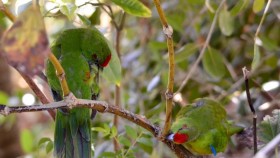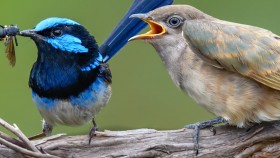Professor Hiroto Naora (1927 – 2019) and the Hiroto Naora Graduate Student Travel Scholarship
Hiroto’s life was shaped by his adventurous spirit and his boundless passion for scientific discovery. His scientific curiosity was stimulated during his childhood in Japan by his father, a palaeontologist, and his mother, a school teacher. Throughout the destruction of WWII and post-war deprivation, Hiroto stoically studied and graduated with a B.Sc. degree from the Tokyo University of Literature and Science in 1950. Thereafter, he pursued doctoral studies in physics under the mentorship of Jun Koana at the University of Tokyo. It was during these years that Hiroto developed what would be become a life-long friendship with the visionary biologist Atuhiro Sibatani. During his doctoral studies, Hiroto designed and constructed the first confocal microscope for the purpose of visualizing DNA in a single cell. He published his seminal research in the journal Science and obtained his D.Sc. degree in 1956. Intrigued by the potential of physics to answer fundamental biological questions, Hiroto sought broader horizons. Supported by a Rockefeller Foundation Fellowship, Hiroto and his wife Hatsuko moved in 1957 to the Université Libre de Bruxelles to work with Jean Brachet, a pioneering proponent of the role of RNA in protein synthesis. Together, they performed elegant studies using algal cells to show that RNA is synthesized in the nucleus and then transported to the cytoplasm. In 1958, Hiroto and Hatsuko moved to the Rockefeller Institute in New York to pursue further studies on nuclear function in the laboratory of Alfred Mirsky. In 1960, they returned to Tokyo where Hiroto took up an appointment at the Cancer Institute. In 1962, at the invitation of his mentor Waro Nakahara, Hiroto became the Foundation Chief of the Biology Division of the newly established National Cancer Centre Research Institute in Tokyo, where he built a team of 50 scientists.
The 1960s heralded an exciting era in the rapidly emerging field of molecular biology and in the expansion of Australian academic research. Hiroto was invited to a senior appointment in the newly formed RSBS at ANU. He established the Molecular Biology Unit in 1968 (which started in a prefabricated hut while RSBS was being built!) and a new life in Australia with Hatsuko and infant daughter Honami. Australia’s vastness and its irreverence resonated with Hiroto’s disdain for elitism, passion for academic freedom and quest to continuously expand his horizons. Against an increasing reductionist trend in molecular biology, he developed the broad conceptual framework that biological activity in diverse contexts and at a variety of levels –molecular, cellular and populational– depends on optimal density. Notably, Hiroto applied his principle of gene ecology to the study of cancer, demonstrating that the cancerous state is not irreversible. During his career, Hiroto received numerous awards and published over 170 research articles and book chapters. His research at RSBS was published in prestigious journals including Nature and Proceedings of the National Academy of Sciences. Hiroto was also a pioneer in fostering collaborations between scientists in Australia and the Asia-Pacific region. During the 1980s, he served as Treasurer and Executive Committee Member of the Australian and New Zealand Society of Cell Biology and as Vice-President of the Asian and Pacific Organization of Cell Biology. He hosted numerous foreign visiting scientists, engaging them in lively scientific discussions and bewildering them with his BBQ skills.
Hiroto is remembered with immense respect and fondness by his laboratory members, many of whom kept in contact with him for 40 years up to his death. They recall the years that they worked with Hiroto as the most intellectually stimulating time of their lives. He emphasized the importance of research integrity and had meticulous standards, but made science enjoyable. Hiroto cultivated a dynamic spirit of discovery in his laboratory and inspired his staff to challenge conventional paradigms. Well into his 80s, he retained his preternatural youthfulness and passion for research. Hiroto was renowned for his generosity, collegiality and modesty, and for his egalitarian manner, treating faculty, research staff and support staff alike with unfailing courtesy. He was especially kind to students, always stopping to ask them how their research was progressing, providing helpful suggestions for vexatious experiments, and desirous to give them opportunities that he himself not had as a student. Although dignified and gentlemanly in manner, Hiroto is also remembered for his cheerful optimism and delightfully mischievous sense of humour. Hiroto embraced Australia wholeheartedly, developing a strong interest in Aboriginal culture and great love for the Australian Bush. His success rate in the RSBS Melbourne Cup sweep was legendary.
Hiroto Naora passed away peacefully in Canberra in early 2019. In a poignant twist, Hatsuko, his beloved wife of 62 years, passed away a few days thereafter. Their daughter, Honami, is an ANU alumni and is a tenured faculty member and research laboratory head at the University of Texas MD Anderson Cancer Center in Houston, U.S.A.
Written by Honami Naora, 31 October 2019
Hiroto Naora Graduate Student Travel Scholarship
Funding for this award was donated to the School by Professor Naora, who was one of the founding faculty members of the ANU Research School of Biological Sciences (RSBS). He joined the School in 1968 and established the Molecular Biology Unit which he directed until his official retirement in the mid-1990s. After retirement, he continued his research at RSBS until 2010. Following Professor Naora’s death in 2019, additional funding for this award was donated by his daughter in his memory.
Read more about the Hiroto Naora Graduate Student Travel Scholarship.
This article is one of a set featuring the achievements and memorable occasions in the History of Biology at ANU.









